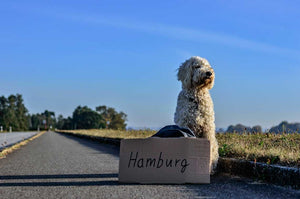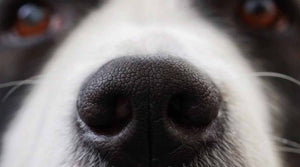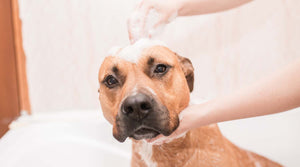Your Cart is Empty
💗FREE shipping on Oprah's Favorite Dog Walking Bag! Everything ships FREE on orders over $30 💗
💗FREE shipping on Oprah's Favorite Dog Walking Bag! Everything ships FREE on orders over $30 💗
💗FREE shipping on Oprah's Favorite Dog Walking Bag! Everything ships FREE on orders over $30 💗
💗FREE shipping on Oprah's Favorite Dog Walking Bag! Everything ships FREE on orders over $30 💗
Add description, images, menus and links to your mega menu
A column with no settings can be used as a spacer
Link to your collections, sales and even external links
Add up to five columns
Add description, images, menus and links to your mega menu
A column with no settings can be used as a spacer
Link to your collections, sales and even external links
Add up to five columns
December 27, 2022 4 min read
Winter is just around the corner. Across the U.S., winter weather often brings snow, ice, or freezing rain. Are you and your pup prepared for the changes?
Harsh road and sidewalk conditions mean pup parents have to pay extra attention to their pup's paws. Most of the salts and deicers that are used to make roads and sidewalks safer for cars, pedestrians, and bicycles are actually toxic to dogs. The main ingredient is often either sodium chloride or calcium chloride, both of which can irritate a dog's paws or cause harm if swallowed. The risk is made worse by the fact that we often can't see the salts and other ice melt products.
In the winter, it's especially important to regularly clean and inspect your pup's paws. Ice make pups more likely to suffer from cuts and abrasions on their paws. Treating any cuts and scrapes early will help soothe your pup and prevent infection later on.
Since pups are more frequently exposed to harmful substances like ice melts and road salts in the winter, you can soak their paws in the tub. Be careful not to give a full bath too frequently, since bathing too often can lead to irritation and dryness, and pups need their natural oils that are produced by their own skin to promote hair growth! We recommend soaking only the soiled paws in an inch or two of lukewarm water. In order to keep it fun for the pups, we like to offer a fun treat like peanut butter spread on a suction cup toy that we stick on the wall!
Use a towel to dry them off thoroughly afterward so there are no slips inside the house.
Next, inspect their paw pads and toes. You'll want to look between their toes, around and between the paw pads, and underneath the nails to make sure all debris has been removed. Otherwise, these can build up and lead to irritation. Very gently part the toes to check for salt and dirt. If anything is left, gently wipe it off with a warm, damp washcloth. Dry thoroughly with a soft towel.
Keep in mind that you are also checking for cracks, cuts, abrasions, and any other signs of dryness and irritation. Just as the lack of humidity in the air in the winter and cold temperatures cause our own skin to dry out and even crack, the exact same thing happens to pups and their paws. If anything doesn't look right, check with your veterinarian right away.
If your pup will be outdoors for lengthy periods of time in extreme conditions, consider waterproof boots or other paw protectors. Not all dogs will take to these, but even breeds that are used to colder weather, such as Siberian Huskies and Alaskan malamutes can benefit from added protection if they will be outdoors for very long periods of time.
As a pup parent, it's important for you to provide good protection for your pup's paws. One way to protect their paws against toxic ice melts and salts is by using a high quality paw wax (also known as paw balm). These soothing formulas serve offer paw protection as well as act as a paw moisturizer. Since paw waxes or paw balms will be absorbed by the paw pads, it's important that the ingredients are non-toxic and safe for dogs.
Pup Wax® is a premium paw wax that protects against dryness and cracked paws all year long and is especially great in the winter. The ingredients are non-toxic and ideal for pups. Get the best paw wax now! Click to shop.
If you're already using a paw wax or paw balm, check the ingredients against our free checklist & petcare ingredient safety guide. Know which ones to avoid!

To apply, simply put a little onto your fingers and gently rub into your pup's paw pads and in between toes.
Gently remove snowballs and ice balls when coming indoors
Snow gets packed into snowballs and balls of ice wedged between your pup's paw pads and toes. Can you imagine what it would feel like to have little snowballs stuck between your toes? It's not comfortable! They are also uncomfortable for pups, which leads them to try to remove them on their own by licking them. This can cause pups to consume harmful toxic chemicals like those in de-icing products and salt.
Don't try to pull snowballs out because you may accidentally pull out your pup's hair - ouch! Instead of tugging on them, soak a washcloth in warm water and massage the icy pad to gently melt and loosen the ice.
Pup Tip: Regular trips to the groomer to trim hair in the paw area can help prevent snowballs and ice balls from forming.
When you're out for the day with your pup, bring moist cleansing wipes that are specially made for pups! They should be made with high quality ingredients that are non-toxic for your pup. This is important because they will probably still end up licking their paws later, and a bit of anything that you apply to their paws will end up absorbed into their bodies.
Pup Tip: Bring Pup WaxTM on the go with our Puppington Limited Edition 7-Day Magic Stick™. Shop now.
Pup tip: This probably goes without saying, but only use non-toxic salt products to melt snow and ice outdoors. Share this post to encourage others in your community to do the same!



Comments will be approved before showing up.